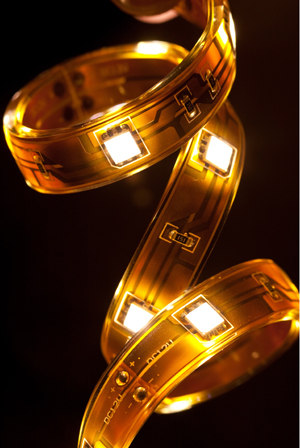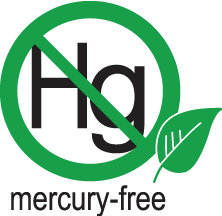LED Basics
Information provided by U.S. Department of Energy.
How is LED lighting different from other energy-efficient lighting technologies?
LEDs offer the potential for cutting general lighting energy use by one-quarter, saving energy dollars and carbon emissions in the process. Their unique characteristics—including compact size, long life and ease of maintenance, resistance to breakage and vibration, good performance in cold temperatures, lack of infrared or ultraviolet emissions, and instant-on performance—are beneficial in many lighting applications. The ability to provide dimming and color control is another benefit of LED lights.
One of the defining features of LEDs is that they emit light in a specific direction. Since directional lighting reduces the need for reflectors and diffusers that can trap light, well-designed LED fixtures can deliver light efficiently to the intended location. In contrast, fluorescent and "bulb" shaped incandescent lamps emit light in all directions; much of the light produced by the lamp is lost within the fixture, reabsorbed by the lamp, or escapes from the fixture in a direction that is not useful for the intended application. For many fixture types, including recessed downlights, troffers, and undercabinet fixtures, it is not uncommon for 40 to 50% of the total light output of fluorescent and incandescent lamps to be lost before it exits the fixture.
How energy efficient are LEDs?
Two aspects of energy efficiency are important to consider: the efficiency of the LED device itself (source efficacy); and how well the device and fixture work together in providing the necessary lighting (luminaire efficacy). How much electricity is used to provide the intended lighting service depends not only on the LED device, but on the lighting fixture design. Because they are sensitive to thermal and electrical conditions, LEDs must be carefully integrated into lighting fixtures. Poorly designed fixtures using even the best LEDs may be no more efficient than incandescent lighting. Conversely, a well-designed LED-based refrigerated display case light that takes advantage of the directional nature of LEDs may use only about half the total watts of a linear fluorescent system to provide the necessary lighting, even though the LEDs have lower source efficacy than the linear fluorescent lamps. Learn more about luminaire efficacy.
Energy performance of white LED products continues to improve rapidly. DOE's long-term research and development goal calls for white-light LEDs producing 160 lumens per watt in cost-effective, market-ready systems by 2025. This chart shows typical luminous efficacies for traditional and LED sources, including ballast losses as applicable.
Typical LED Efficacy Compared to Conventional Lighting Technologies in 2010 |
|
Product Type |
Typical Luminous Efficacy (in lm/W) |
LED cool white package |
130 |
LED warm white package |
93 |
LED A19 lamp (warm white) |
64 |
LED PAR38 lamp (warm white) |
52.5 |
High intensity discharge (high watt) |
120 |
Linear fluorescent |
118 |
High intensity discharge (low watt) |
104 |
Compact fluorescent lamp |
63 |
Halogen |
20 |
Incandescent |
15 |
Do LEDs provide high quality lighting?
Key aspects of lighting quality are color appearance (whether a white light appears more yellow/gold or more blue) and color rendering (the ability of the light source to render colors, compared to incandescent and daylight reference sources).
Color appearance. Color appearance is measured by correlated color temperature (CCT) on the Kelvin (K) scale. For most interior lighting applications, warm white (2700K to 3000K) and in some cases neutral white (3500K to 4000K) light is appropriate. Many products use cool-white LEDs with very high CCT (bluish in appearance) since they tend to offer higher efficacy at low cost, but an increasing number of LED products are available in warm-white or neutral-white. They are less efficient than cool white LEDs, but have improved significantly, to levels almost on par with CFLs.
Color rendering. The color rendering index (CRI) measures the ability of light sources to render colors, compared to incandescent and daylight reference sources. The leading high-efficiency LED manufacturers now claim a CRI of 80 for phosphor-converted, warm-white devices. In general, a minimum CRI of 80 is recommended for interior lighting. The CRI has been found to be inaccurate for RGB (red, green, blue) LED systems. A new metric is under development, but in the meantime, color rendering of LED products should be evaluated in person and in the intended application if possible.
Color quality. CCT and CRI have been used for many years in describing conventional lighting, but they are not adequate for SSL. Two LED light sources with identical CCTs can render object colors very differently due to the differences in spectra. While CCT provides an indication of whether a light source may appear yellowish or bluish in color, Duv is needed as a supplemental metric to prevent excessively greenish or pinkish hues. Similarly, CRI value is poor at predicting the quality of the appearance of saturated red objects, and doesn't correspond well to human perception of color quality. The National Institute of Standards and Technology (NIST) has developed a Color Quality Scale (CQS) that is intended to replace or supplement the current CRI. The developers believe CQS will better capture what most humans perceive as superior color rendering.
How long do LEDs last?
Unlike other light sources, LEDs usually don't "burn out"; instead, they get progressively dimmer over time (a process called lumen depreciation). LED useful life is typically based on the number of operating hours until the LED is emitting 70 percent of its initial light output. Good-quality white LEDs in well-designed fixtures are expected to have a useful life of 30,000 to 50,000 hours. A typical incandescent lamp lasts about 1,000 hours; a comparable CFL lasts 8,000 to 10,000 hours, and the best linear fluorescent lamps can last more than 30,000 hours.
Are LEDs cost-effective?
Costs of LED lighting products vary widely. Good-quality LED products currently carry a significant cost premium compared to standard lighting technologies. However, costs are declining rapidly. Recent industry roadmapping indicates prices for warm white LED packages have declined by half, from approximately $36 to $18 per thousand lumens (kilolumens, or klm) from 2009 to 2010. Prices are expected to decline significantly, to approximately $2/klm by 2015. It is important to compare total lamp replacement, electricity, and maintenance costs over the expected life of the LED product.






